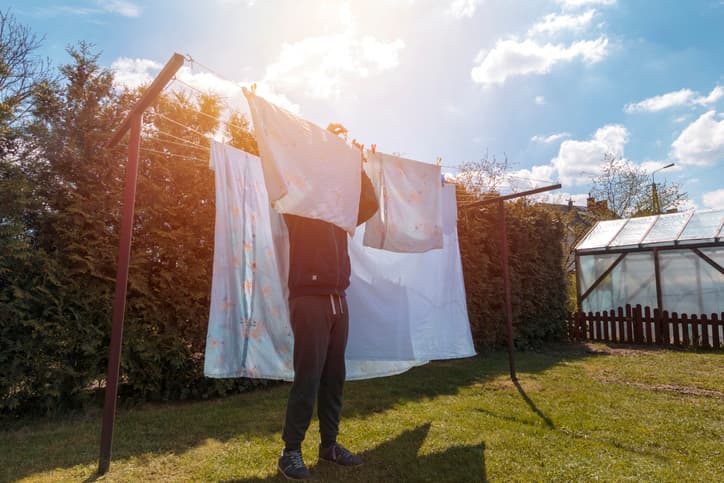Ways To Dry Your Clothes At Home
Top Drying Tips

For many people, it feels like the household’s laundry simply never ends. From getting the kids’ football kit washed and dried in time for training the next day to ensuring you have enough clean outfits for work, this basic everyday chore can be a real drag, especially when you have a large family. Perhaps the most challenging aspect of getting the laundry done is finding ways to dry your clothes at home. While tumble dryers are convenient, they can be expensive to run and are not very eco-friendly. So, what are the money-saving alternatives that can also reduce your carbon footprint?
To help you step up your laundry game, we’ve put together this handy guide that will help you to dry your clothes quickly and efficiently without having to resort to a power-hungry tumble dryer or even a trip to the local laundrette. Follow these simple tips and you can’t go wrong!
How To Dry Clean Clothes
One way to avoid having to dry your clothes after they have been through the washing machine is to dry clean them. Indeed, a lot of the time there is no need to wash your items in the machine or take them to a professional dry cleaners - a quick dry clean can be done at home. While this method may not be appropriate for exceedingly dirty items, such as a muddy sports kit, work overalls, or items that have been worn on multiple occasions without a traditional wash in between, for example, many garments that have only been worn once or twice since their last wash can be dry cleaned at home. To do this, simply follow the instructions below:
Spot Clean
Providing there are no large stains on the garment, spot cleaning the surface of the item is usually enough to remove any small marks. To do this, dampen a microfibre cloth with warm water mixed with a few small drops of detergent. Use this damp cloth to then dab at any marked areas, paying particular attention to around the neckline and armpits on shirts or t-shirts. For more stubborn marks, gently rub the affected area, ensuring you are not making the item overly wet. Once finished, wring out the item to remove any excess water.
Hang To Air Out
So long as an item is not stained or overly dirty, airing it for 48 hours on a washing line (or inside near an open window, if it is raining) is typically enough to refresh it. Once small marks have been removed using the spot clean method, airing it will allow the item to dry while all stale smells associated with everyday wear are removed.
Iron and Hang
Once the item has been spot cleaned and aired, all that’s left to do is iron the garment and use a clothes hanger to ensure the item is crease and wrinkle-free next time you wear it. At this stage you can also use a fabric freshener spray to ensure it smells as fresh as possible the next time you take it out of your cupboard.
Can A Fan Dry Clothes?
Unsurprising, the best method of drying washed clothes without the use of a tumble dryer is to hang them on a washing line and let them dry out naturally in the wind and sunshine. However, sometimes this is not an option, especially during winter when cold and wet weather prevents clothes from drying properly outside. However, there are other ways to dry clothes in a similar fashion.
For example, you can use a fan to dry items of laundry. Just like when hung on a line outside, if you hang your wet items on a clothes horse and direct a fan at it, drying occurs thanks to accelerated evaporation. This happens because, when the air that is surrounding your clothes is moved by the fan, water is absorbed from the clothes. For this reason, fans can speed up the drying process, turning the water molecules in the items into water vapor as the moving air passess through them.
It’s also worth noting that a higher temperature can also increase the evaporation rate. This means if your clothes are also placed near a hot radiator, the combination of the heat and the moving air created by the fan can help to speed up the time it takes for your clothes to dry.
How Much Does It Cost To Run A Tumble Dryer?
Tumble dryers are not a good idea if you are trying to save money and conserve energy in your home. A tumble dryer can cost anything between 40 cents and €1 to dry an average-sized load. While an A++ rated machine may only use 230kWh/year (based on the official rating standard), a C rated tumble dryer will use as much as 585kWh/year. This works out at 5kWh per load. To put this into context, the average A+ combi fridge-freezer only uses between 150 and 190kWh per year, and this device is typically running 24/7.
Is Drying Clothes Inside Bad For You?
Although drying your clothes inside is, on the whole, a safe and necessary practice, for those who suffer from asthma and other respiratory illnesses, doing this on a regular basis is thought to worsen symptoms. This is because wet garments that are left to dry on clothes horses or radiators can increase indoor moisture levels by up to 30%, which in turn can encourage the growth of mould in your home. When mould starts to develop, it can release spores into the air which, when inhaled, can trigger asthma attacks and worsen symptoms.
However, as long as you dry washing outside where possible, and only dry it inside in well-ventilated rooms of your home, the health risks are minimal.
